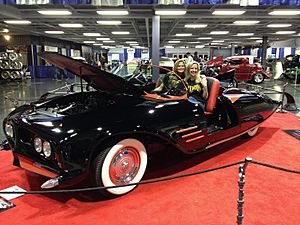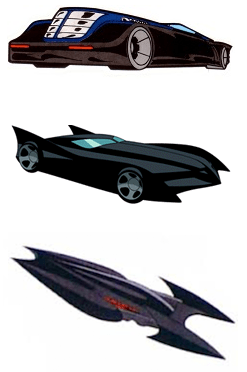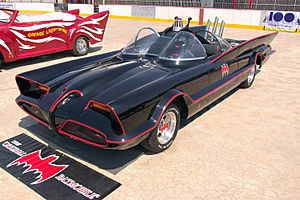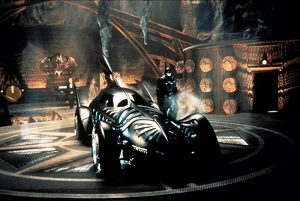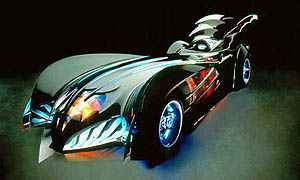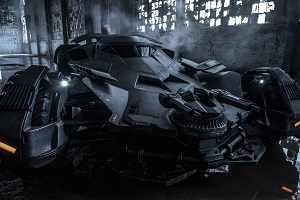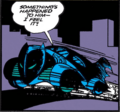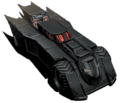Batmobile facts for kids
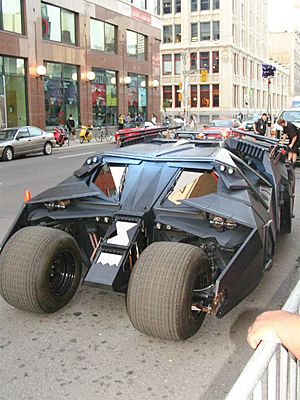
The Batmobile is the super cool car that Batman and Robin use to fight crime! It was built by Lucius Fox at Wayne Enterprises. The Batmobile has been in every Batman movie, but in Christopher Nolan's The Dark Knight Trilogy, it was called The Tumbler. This amazing car is packed with lots of weapons and gadgets.
The Batmobile's look has changed a lot over the years. But since its first appearance, it has always had a bat-like design, often with cool wing-shaped tailfins. At first, it was a tough, armored car. Over time, it became a super sleek and armored supercar-hybrid. It's the most high-tech tool Batman has to fight bad guys. Each new Batmobile shows off the latest car technology. It's used for many things like chasing criminals, carrying prisoners, controlling riots, and even as a moving crime lab. Sometimes, the Batmobile can even drive itself! You can find the Batmobile in every Batman story, from comic books and TV shows to movies and video games. It's a true pop culture icon!
Contents
- Early Batmobiles and Tours
- Animated Batmobiles
- Live-Action Batmobiles
- Batmobile Toys
- Batmobile in Video Games
- Images for kids
- See also
Early Batmobiles and Tours
Did you know the first car ever shown as a Batmobile to the public was built way before the famous TV show car? It was made in 1960 and finished in 1963 by Forrest Robinson. He used a 1956 Oldsmobile 88 car and built a special body for it.
This car was first used as a regular car. Later, a company that worked with DC Comics (who own Batman) leased it. They painted it in Batman colors, added official Batman stickers, and toured it as "Batman's Batmobile" in small towns. It helped advertise a Batman dessert product line!
After the famous 1966 TV Batmobile was made, this first Batmobile was returned to Robinson. He removed the Batman stickers, painted it silver, and used it as his daily car again before selling it. After sitting in a field for almost 50 years, the car was sold in 2008. It was then restored in 2013 by an expert car restorer named Mario Borbon.
Animated Batmobiles
The Batmobile has appeared in many animated shows and movies.
The Batman/Superman Hour (1968)
The Batmobile from the 1968 Filmation TV series was very unique. It had a long, black body with a big, light blue bat symbol on the hood. This symbol could even fold its "wings" to become a barricade or chain cutter! Unlike other Batmobiles, it had a single windshield and tall bat-fins.
This Batmobile could also use parachutes, inflatable floats, and even jets to lift and move the car like a hovercraft! It was one of the few Batmobiles that didn't appear in comic books or have toys made of it.
Super Friends (1973-1986)
The first Batmobile in Super Friends looked a lot like the one from the 1960s live-action TV show. A big change was that this animated version had yellow bat emblems on the doors. The comics soon started using this feature too!
In 1978, the Batmobile in Challenge of the Super Friends got a new, more aerodynamic look. It was smaller and had a sloped nose. But it kept some classic features like the Bat-mask, low fins, twin bubble windshields, and blue color.
DC Animated Universe (1992-2006)
The Batmobile showed up in many shows in the DC animated universe.
Batman: The Animated Series (1992)
The Batmobile in Batman: The Animated Series mixed different styles. It was long, low, and had square lines, long fins, and a big chrome grill. It even looked a bit like the Batmobile from the first two Tim Burton movies. Even though it had a jet exhaust, the show often used sounds of a regular engine. This suggests it had a big piston engine for normal driving and a jet for super-fast acceleration. It could also become armored when Batman left it, so no one could mess with it.
Cool Features
Here are some of the Batmobile's cool features:
- Smoke and oil dispensers
- Wheel slashers
- Missile rack
- Tear gas dispensers
- Ejection seats
- Super strong titanium alloy wheels and body
- Reversible jet exhausts
- Shield platings
The New Batman Adventures (1997)
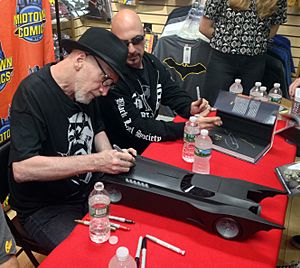
The Batmobile was redesigned in The New Batman Adventures. The jet engine was gone in this version. This design was also used in Justice League and Justice League Unlimited. Its cockpit windows were bulletproof. If a tire got shredded, a new one would pop out right away!
Batman Beyond (1999)
A totally new, flying Batmobile appeared in Batman Beyond, used by the new Batman, Terry McGinnis. Flying cars were common in this future world. This Batmobile looked very different from others. It was a simple, sleek pod with sharp angles, not really having the usual bat-like features.
It had a red-lit cockpit for one person, with lots of computer screens. It was armed with missiles that could stop enemies and grappling cables. It was not meant for two people, as Terry's friend Maxine found out! According to Bruce Wayne, it could fly at Mach 3 (three times the speed of sound), but Terry never went that fast in Gotham City. It had a special hatch for quick exits and entrances. Like Terry's batsuit, the Batmobile could turn invisible or disguise itself as a garbage dumpster to hide from curious eyes. It also had cameras and recorders to collect evidence.
The Batman (2004)
In The Batman animated series, the Batmobile looked like a sports car with several jet exhausts. In one episode, this Batmobile was destroyed. Batman then built a new, longer, and lower prototype with one triangular jet exhaust. He liked it so much, he kept it! In a future episode, a tank-like Batmobile appeared, similar to Frank Miller's design from The Dark Knight Returns.
Batman: The Brave and The Bold (2008)
The Batmobile in Batman: The Brave and the Bold took ideas from older comic book Batmobiles and the Lincoln Futura car. This Batmobile could even change into other vehicles, like a jet or a giant robot! In one episode, Batman had to use a backup Batmobile that looked like a Studebaker.
Beware the Batman (2013)
The Batmobile in Beware the Batman was a low, flat, F1-like car with a single seat and a pointed nose. It had horizontal fins and jet engines. This Batmobile was super tough, surviving rocket launcher hits and even breaking demolition machinery without a scratch! Its inside had a voice command system and a video link to the Batcomputer.
The LEGO Movie (2014)
In The LEGO Movie, a big six-wheeled Batmobile appeared. It had huge sub-woofers and could also turn into the Batwing. It was destroyed during an attack on Cloud Cuckoo Land.
The LEGO Batman Movie (2017)
In The LEGO Batman Movie, many different Batmobiles from various Batman stories appeared. Batman himself drove the "SpeedWagon" Batmobile, which was inspired by earlier designs. This Batmobile used "atomic batteries," a feature from the 1960s versions. Other Batmobiles seen briefly included those from the 1960s TV show, Tim Burton movies, Batman Forever, and The Dark Knight trilogy.
Live-Action Batmobiles
Batman's car has changed a lot in live-action movies and TV shows.
Early Serials (1943, 1949)
In the 1943 movie serial Batman, Bruce Wayne and Dick Grayson used a black 1939 Cadillac Series 61 convertible. They drove it with the top down as Bruce and Dick, and with the top up as Batman and Robin. Their butler, Alfred, often drove them. In the 1949 serial Batman and Robin, they drove a 1949 Mercury.
Batman TV Series (1966)
The most famous Batmobile from the 1966–1968 TV show started as a special 1955 Lincoln Futura concept car. This car was built by hand in Italy and cost a lot of money!
Hollywood car customizer George Barris bought the Futura for a very low price. When he needed to build a Batmobile quickly for the TV show, he decided to transform the unique Futura. He finished it in just three weeks! Barris kept the car and leased it to the TV show.
At first, the car had some problems because it was old. But it became super famous! Many later Batmobiles have a rear rocket thruster that fires when the car starts, inspired by this one. In 2013, this original Batmobile was sold for an amazing $4.2 million!
Cool Features
This Batmobile had many gadgets: a Cable Cutter Blade, Bat Ray Projector, Anti-Theft Device, Detect-a-scope, Batscope, and more! It could also do a quick 180-degree "bat-turn" using two parachutes at the back.
Tim Burton's Films (1989, 1992)
The Batmobile in Tim Burton's films Batman (1989) and Batman Returns (1992) looked very different. It was long, low, and sleek, matching the Art Deco style of Gotham City in those movies. This Batmobile is now in the Petersen Automotive Museum in Los Angeles.
Technical Details
- Length: 260.7 inches (about 21.7 feet)
- Acceleration: 0-60 mph in 3.0 seconds
- Top Speed: 330 mph with a booster!
- Engine: Jet Turbine
- Fuel: Special gasoline and paraffin mixture
Cool Features
This Batmobile had side-mounted grappling hook launchers and a central "foot" carjack that could lift the car and spin it 180 degrees. It could drop spherical bombs and had an afterburner for speed. Two machine guns were hidden in the fenders. Its grappling hook helped it make super sharp turns. It also had oil slick dispensers and smoke emitters.
Inside, the two-seat cockpit looked like an airplane, with lots of instruments and a voice-command system. In Batman Returns, it had a "Batmissile" mode where the wheels would pull in, and the sides would break off, turning it into a thin, bullet-like vehicle to squeeze through tight spaces.
The Batmobile had special ceramic fractal armor panels that would explode outwards to deflect attacks. Batman could also activate a shielding system with a voice command, making the car completely bulletproof and fireproof when left alone.
Joel Schumacher's Films (1995, 1997)
Batman Forever (1995)
When Joel Schumacher directed the Batman films, the Batmobile got a new look. It had cool lights on its rims, sides, and front. Its wing-shaped fins were much taller. This car had unique features: it could turn its wheels 90 degrees to move sideways, and a grappling hook allowed it to drive up walls! It was also fast enough to jump across buildings.
The "driving up walls" feature was shown when Batman escaped from Two-Face. Later, Dick Grayson (Robin) took the Batmobile for a joyride. Sadly, it was destroyed when the Riddler blew it up. Batman famously said, "It's the car, right? Chicks love the car."
Technical Details
- Length: 300 inches (25 feet!)
- Height: 126 inches (10.5 feet)
- Top Speed: 330 mph with a booster
- Engine: Chevrolet 350 ZZ3 V8 engine
- Body: Made from Carbon fiber
Cool Features
The Batman Forever Batmobile had glowing blue lights on its engine panels, wheels, and underside. Its roof fin could open into a "V" shape. The wheels had bat emblems that stayed upright even when the wheels spun. The two-seat cockpit had a rear-view monitor and system displays.
For defense, it could lock all four wheels sideways for quick moves. For extreme situations, it could shoot grappling cables upwards and use its jet exhaust to climb straight up building walls!
Batman & Robin (1997)
A new Batmobile appeared in the 1997 film Batman & Robin. It was very aerodynamic and could make super-fast 90-degree turns at over 70 mph without losing speed.
Technical Details
- Length: 396 inches (33 feet!)
- Height: 59.05 inches (about 5 feet)
- Top Speed: 230 mph on open road, 350 mph with afterburner
- Engine: Chevy 350 ZZ3 (off-road racing motor)
- Tires: Custom 22-inch wheels with huge 55-inch GoodYear tires that had Batsymbols in their treads!
Cool Features
This Batmobile had no passenger seat and no canopy. It had light-up wheels and engine panels, with lots of red, orange, yellow, and blue lights. Instead of one jet exhaust, it had six smaller ones that formed a "V" shape. A bat mask was built into the car's nose. The fins were the biggest ever on a real-world Batmobile!
Its weapons and gadgets were controlled by a voice-activated computer. It had rocket launchers, grappling hooks, infrared and laser tracking, wheel-based axle bombs, an ejection seat, and a hidden central part that could detach to become an emergency vehicle. The single-seat cockpit had a video screen and radar.
The Dark Knight Trilogy (2005, 2008, 2012)
The Batmobile in Christopher Nolan's Batman films looks more like a tank than a sleek car. It's called the Tumbler in the movies. The film's designer said it was like a mix between a Lamborghini and a tank.
In Batman Begins (2005), Bruce Wayne uses this prototype military vehicle. It has weapons and can boost itself into a "rampless jump." Its armor is so strong it can smash through concrete barriers! Several real-life versions were built for filming, including one with a real jet engine fueled by propane tanks.
In The Dark Knight (2008), the Tumbler appears again. Batman uses it to capture the Scarecrow. Later, it's damaged by a rocket-propelled grenade fired by the Joker. Batman then ejects from the Tumbler in the Batpod (a motorcycle made from the Tumbler's front wheels) as the Tumbler self-destructs.
In The Dark Knight Rises (2012), several Tumblers are seen. These are stolen from Wayne Enterprises by Bane's gang and used to control Gotham. Batman and Selina Kyle (Catwoman) destroy three of them.
Technical Details
- Length: 15 feet 2 inches
- Width: 9 feet 2 inches
- Height: 4 feet 11 inches
- Weight: 2.5 tons
- Acceleration: 0-60 mph in 5.6 seconds
- Engine: 5.7 liter GM V8 engine with 500 horsepower
- Fuel: The "jet engine" on the back used propane tanks.
- Tires: Huge "Super Swamper TSL" tires in the back and "Hoosier Checkerboard" dirt tires in the front for amazing grip.
Cool Features
The Tumbler has two autocannons mounted in the front. In "Attack" mode, the driver's seat moves to the center, and Batman lies face-down. This protects him better and helps him make super precise turns. Other features include:
- Rear flaps to help with braking
- A rocket launcher
- An integrated fire-extinguishing system
- A Jet engine (with afterburners) for quick boosts and "rampless" jumps
- Stealth mode to avoid detection by radar, infrared, and sound. The lights and main engine turn off, and it runs on a quiet electric motor.
- Explosive caltrops dropped from the back to stop chasing cars.
- A heavily armored front for ramming enemies.
- Both front wheels can eject to form the Batpod motorcycle if the vehicle is damaged. The rest of the Tumbler then self-destructs.
- The new Tumblers in The Dark Knight Rises had missile launchers and a retractable artillery cannon.
DC Extended Universe (2016)
The Batmobile in Batman v Superman: Dawn of Justice (2016) combines ideas from classic Batmobiles and the tough Tumbler. It's about 20 feet long and 12 feet wide. Unlike older Batmobiles, it has a gatling gun on the front and special tractor tires on the back. It can raise itself for battle or jumps and lower itself for cruising. This Batmobile also appeared in a flashback in Suicide Squad, when Batman chased the Joker and Harley Quinn.
In the film Justice League, Batman has a new vehicle called the Nightcrawler, which was designed by his father.
Batmobile Toys
- Hot Wheels has made many Batmobile toys, including versions from the 1960s TV show, Tim Burton's films, and Nolan's Tumbler.
- Corgi Toys from England has produced many Batmobile models, plus a Batboat and Jokermobile.
- Mego made a Batmobile for its action figure line in the 1970s that could fit two figures.
- The Batmobile toy from Kenner's Super Powers Collection could fit two figures and had a battering ram and a trapping claw.
- Eaglemoss released a magazine called 'Batman Automobilia' with models of most Batmobiles.
- Jada Toys released a model kit of the Batmobile from Batman v Superman: Dawn of Justice.
- Kinder Surprise and Chupa Chups have also released small Batmobile toys.
- Hot Toys has made very detailed Batmobile models from various films and TV shows.
Lego Batmobiles
- The Batmobile was part of the original Lego Batman toy line and its DC Universe Superheroes remake. These sets often included Two-Face and his armored truck.
- A large Lego Tumbler set (with 1869 pieces!) was released for The Dark Knight. This set even included a Lego version of the Joker.
Batmobile in Video Games
- In the Sega CD game Batman Returns, you could control the Batmobile in special bonus stages.
- The 2005 video game Batman Begins had two Batmobile levels. Players could ram enemy cars off the road, which was a highlight of the game!
- In the PlayStation game Batman: Gotham City Racer, players could drive the Batmobile freely.
- In DC Universe Online, the Batmobile is destroyed by a robot controlled by Brainiac.
- In 2016, the game Rocket League released a Batmobile car pack to go with the movie Batman v Superman: Dawn of Justice.
Batman: Arkham Series
First Design (Arkham Asylum, Arkham City, Arkham Origins)
In Batman: Arkham Asylum, the Batmobile looked a lot like the one from the 1989 Batman film and Batman: The Animated Series. In the game, Harley Quinn and prisoners vandalize it. Batman later uses it remotely to take Bane into the sea.
In Batman: Arkham City, the Batmobile is seen in the Batcave, being rebuilt after its fight with Bane. So, it's not used much in that game. In Batman: Arkham Origins, a prototype Batmobile was being built by Batman in the Batcave. It was called the "Urban Assault Vehicle." After Bane destroyed the Batcave, this early Batmobile was also destroyed.
Second Design (Arkham Knight)
In Batman: Arkham Knight, a new Batmobile appears. It keeps its classic shape but is also heavily influenced by The Dark Knight Trilogy Tumbler. This car is super heavy and almost impossible to destroy! It can be called to Batman instantly and can even eject him high into the air to start gliding. Batman can also control it remotely. The Batmobile can even help Batman in fights with special moves. Like Batman's suit, the Batmobile can be upgraded and has different looks, including one based on the 1960s TV series Batmobile.
Two Cool Modes
The Arkham Knight Batmobile has two modes it can switch between: Pursuit Mode and Battle Mode.
"Pursuit Mode"
Pursuit Mode is for driving around the city and racing on tracks set up by the Riddler. It has boost and jump features, non-deadly missiles to stop enemy cars, and an EMP taser to stun criminals.
- Engine: Hybrid (WayneTech power cell with jet turbine)
- Horsepower: 1200 bhp
- Top Speed: 336.5 km/h (209 mph)
- Acceleration: 0-96.6 km/h (0-60 mph) in 2.7 seconds!
- Afterburner: Uses Nitro methane, increases speed by 30%.
- Cockpit: Has an ejector seat and an advanced Batcomputer.
- Wheels: Made of super strong synthetic fiber, 4 feet 7 inches (1.40 m) wide, for great grip on all surfaces.
- Air Brakes: Made of graphene, reduces stopping distance by 78%.
"Battle Mode"
Battle Mode turns the Batmobile into a tank-like form. It widens its suspension, and its LED headlights turn from blue to red. In this mode, a remote-controlled turret rises from the top with many weapons for fighting armored vehicles, aircraft, and even non-lethal weapons for people.
- Armor: 120mm thick, made of carbon nanotubes, with explosive reactive armor around the cockpit.
- Vulcan Gun: 25mm gun for anti-tank and surface-to-air combat.
- 60mm Cannon: Fires high-explosive shells that can go through thick steel armor.
- Riot Suppressor: Fires non-lethal rubber pellets to stop combatants without serious injury.
- Electroshock Defense: Sends out electric pulses (200-300 kv) from rods to propel enemies and disable vehicles.
- Gyroscopic Wheels: Allow 360-degree spins for combat moves.
- Winch: A multi-purpose grapple claw that can support 2.2 tons!
More Features
The driver sits in the center, face down, for better protection in combat. The bulletproof Batmobile can be called to Batman's location instantly. Batman can eject from it and immediately start gliding. It can jump, boost speed, spin on the spot, and smash through objects. Some enemies will even run away just by seeing it!
The Batmobile can be upgraded with new abilities, like an EMP device to stun enemy drones or a "drone virus" to make enemy vehicles attack each other. It can also be controlled remotely and used to solve puzzles in the game, like lowering an elevator with its winch.
Images for kids
-
The patent for the 1966 television Batmobile, built by George Barris.
See also
 In Spanish: Batmobile para niños
In Spanish: Batmobile para niños


